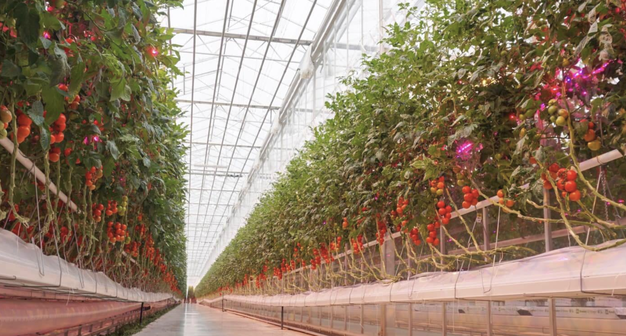What if your brand-new greenhouse gets infected with rugose? That's what happened to the team at the UK greenhouse company La Serra. "At first, we thought it was a strong mixed pepino infection, but rugose was found as well," shared Nick Arnst last week during the British Tomato Conference. As he has been working very closely with other parties, such as labs, seed producers, and others in the industry, to get ahead of this issue as quickly as possible, he also wants other growers to learn from their experiences in eradicating the virus. "Do not attempt to clean an infection yourself."

NFT and substrate
The La Serra tomato greenhouse in Throckmorton, England, is remarkable as it combines NFT and substrate growing of tomatoes, both on 4 hectares. The site is powered by CHP through a Biogas Anaerobic Digester and a large solar farm. In short, it is a very cool site – and thus, the growers also opted for the newest available LED fixtures for their hybrid top and interlights.
However, during the realization back in 2019, not all lamps were available at the scheduled time, meaning contractors were still on-site once plants were in and growing. "We had strict protocols, including contractors bringing new clothes, using our own trolleys, and taking all measures that could be taken," Nick recalls. In hindsight, he also looks at employees moving from a different greenhouse, which was located on the same site as a packhouse. "Issues with labor availability and the experience level led to us moving staff to other sites."
 Nick shared his learnings during the British Tomato Conference
Nick shared his learnings during the British Tomato Conference
Pepino and rugose
What the cause was will never be certain, but after the first crops were planted in July 2019, the growers started seeing what looked like a strong mixed pepino infection in November 2019 – something that was confirmed by specialist tests. "You can grow out of that," says Nick. But in March 2020, the APHA carried out a national survey of tomato growers, and the La Serra results came back with strong positive results. "We indeed had a strong pepino and rugose infection."
The growers cleaned, cleaned, and cleaned, burned the crop on-site, swabbed for testing of the virus, and after these came back negative, replanting commenced – but by the end of the year, mild symptoms were found in the fresh crop. A more intense cleaning and disinfection process happened, but by the end of the year, research confirmed reinfection took place once more. The company decided to hire a specialist glasshouse disinfection/cleaning contractor in July 2022. Equipped with a dedicated kit, this team had been successful in disinfecting the virus from other commercial greenhouses in the Netherlands and abroad. "With this kit, including pumps, additional hoses, and everything needed, we followed the protocol, which included continual soaking of the structure over multiple days, with special tools to ensure thorough cleaning under the gutters, and also treating the screens with specialized equipment," Nick shares. And it worked: the virus has not been seen. "This year, we've hired the company again, and their visit has become a standard protocol in our cleaning."
What to learn
This doesn't mean hygiene measures are not important anymore – they remain hugely important, as Nick believes resistant varieties are the only way out of this currently. He shared his story during the British Tomato Conference to share with other growers what worked for them and what didn't. "What to learn? Do not attempt to clean an infection yourself," he says. "Specialists have the right equipment and can target specific areas," he explains, adding that he understands that in case of an infection, individual commercial decisions need to be made depending on the age of the crop. The longer an infected crop stays in the greenhouse, the higher the viral load on the site will be.

For more information:
La Serra
https://www.laserra.org.uk

